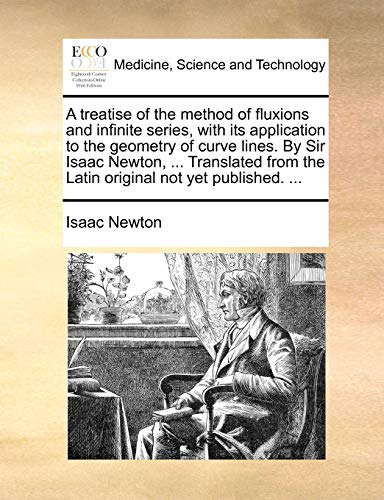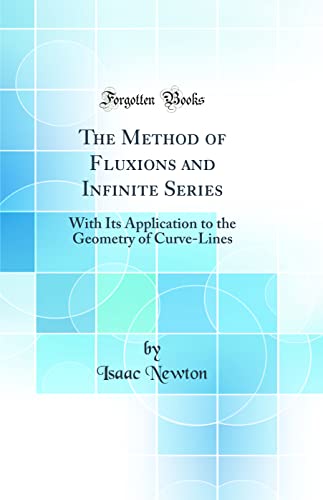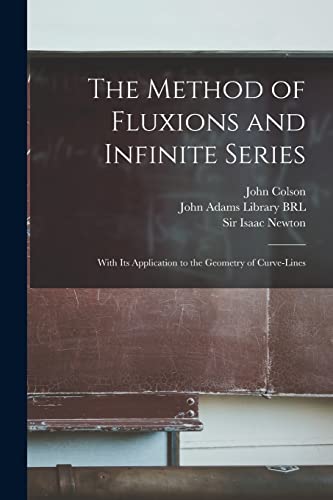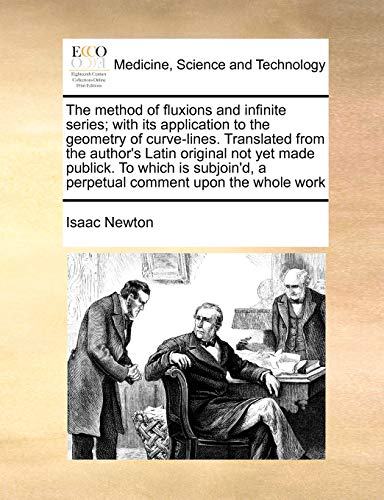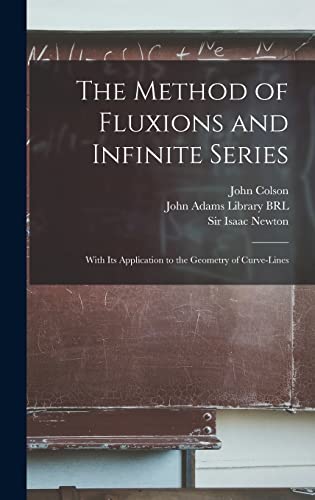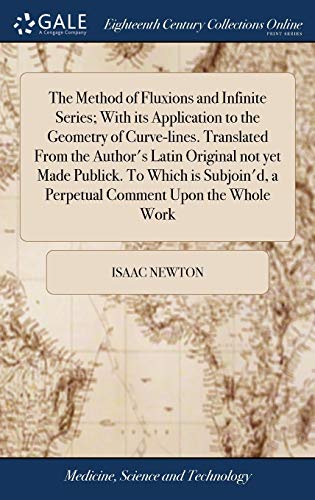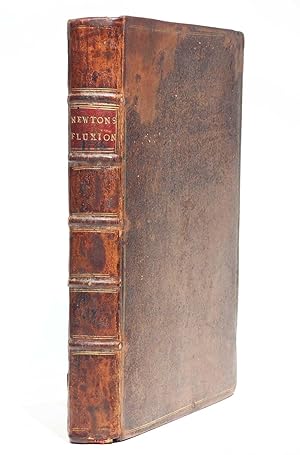method fluxions infinite series application von newton isaac (15 Ergebnisse)
FeedbackSuchfilter
Produktart
- Alle Product Types
- Bücher (15)
- Magazine & Zeitschriften (Keine weiteren Ergebnisse entsprechen dieser Verfeinerung)
- Comics (Keine weiteren Ergebnisse entsprechen dieser Verfeinerung)
- Noten (Keine weiteren Ergebnisse entsprechen dieser Verfeinerung)
- Kunst, Grafik & Poster (Keine weiteren Ergebnisse entsprechen dieser Verfeinerung)
- Fotografien (Keine weiteren Ergebnisse entsprechen dieser Verfeinerung)
- Karten (Keine weiteren Ergebnisse entsprechen dieser Verfeinerung)
- Manuskripte & Papierantiquitäten (Keine weiteren Ergebnisse entsprechen dieser Verfeinerung)
Zustand
Einband
Weitere Eigenschaften
- Erstausgabe (2)
- Signiert (Keine weiteren Ergebnisse entsprechen dieser Verfeinerung)
- Schutzumschlag (Keine weiteren Ergebnisse entsprechen dieser Verfeinerung)
- Angebotsfoto (7)
Sprache (2)
Preis
- Beliebiger Preis
- Weniger als EUR 20 (Keine weiteren Ergebnisse entsprechen dieser Verfeinerung)
- EUR 20 bis EUR 40
- Mehr als EUR 40
Gratisversand
Land des Verkäufers
Verkäuferbewertung
-
A Treatise of the Method of Fluxions and Infinite Series, with Its Application to the Geometry of Curve Lines. by Sir Isaac Newton, ... Translated from the Latin Original Not Yet Published. ...
Verlag: Gale Ecco, Print Editions, 2010
ISBN 10: 1170175570 ISBN 13: 9781170175576
Sprache: Englisch
Anbieter: Ria Christie Collections, Uxbridge, Vereinigtes Königreich
EUR 23,26
Währung umrechnenEUR 5,77 für den Versand von Vereinigtes Königreich nach DeutschlandAnzahl: Mehr als 20 verfügbar
In den WarenkorbZustand: New. In.
-
The Method of Fluxions and Infinite Series With Its Application to the Geometry of CurveLines Classic Reprint
Anbieter: PBShop.store UK, Fairford, GLOS, Vereinigtes Königreich
EUR 26,52
Währung umrechnenEUR 4,57 für den Versand von Vereinigtes Königreich nach DeutschlandAnzahl: 15 verfügbar
In den WarenkorbHRD. Zustand: New. New Book. Shipped from UK. Established seller since 2000.
-
The Method of Fluxions and Infinite Series: With its Application to the Geometry of Curve-lines
Anbieter: Ria Christie Collections, Uxbridge, Vereinigtes Königreich
EUR 26,49
Währung umrechnenEUR 5,77 für den Versand von Vereinigtes Königreich nach DeutschlandAnzahl: Mehr als 20 verfügbar
In den WarenkorbZustand: New. In.
-
The Method of Fluxions and Infinite Series; With Its Application to the Geometry of Curve-Lines. Translated from the Author's Latin Original Not Yet ... a Perpetual Comment Upon the Whole Work
Verlag: Gale Ecco, Print Editions, 2010
ISBN 10: 1170987303 ISBN 13: 9781170987308
Sprache: Englisch
Anbieter: Ria Christie Collections, Uxbridge, Vereinigtes Königreich
EUR 26,52
Währung umrechnenEUR 5,77 für den Versand von Vereinigtes Königreich nach DeutschlandAnzahl: Mehr als 20 verfügbar
In den WarenkorbZustand: New. In.
-
The Method of Fluxions and Infinite Series: With its Application to the Geometry of Curve-lines
Anbieter: moluna, Greven, Deutschland
EUR 33,79
Währung umrechnenKostenlos für den Versand innerhalb von/der DeutschlandAnzahl: Mehr als 20 verfügbar
In den WarenkorbZustand: New.
-
A Treatise of the Method of Fluxions and Infinite Series, With its Application to the Geometry of Curve Lines. By Sir Isaac Newton, ... Translated From the Latin Original not yet Published.
Verlag: Gale Ecco, Print Editions, 2018
ISBN 10: 1385096209 ISBN 13: 9781385096208
Sprache: Englisch
Anbieter: Ria Christie Collections, Uxbridge, Vereinigtes Königreich
EUR 33,00
Währung umrechnenEUR 5,77 für den Versand von Vereinigtes Königreich nach DeutschlandAnzahl: Mehr als 20 verfügbar
In den WarenkorbZustand: New. In.
-
A Treatise of the Method of Fluxions and Infinite Series, With its Application to the Geometry of Curve Lines. By Sir Isaac Newton, . Translated From the Latin Original not yet Published.
Verlag: Gale Ecco, Print Editions, 2018
ISBN 10: 1385096209 ISBN 13: 9781385096208
Sprache: Englisch
Anbieter: moluna, Greven, Deutschland
EUR 38,60
Währung umrechnenKostenlos für den Versand innerhalb von/der DeutschlandAnzahl: Mehr als 20 verfügbar
In den WarenkorbZustand: New.
-
The Method of Fluxions and Infinite Series: With its Application to the Geometry of Curve-lines
Anbieter: moluna, Greven, Deutschland
EUR 40,03
Währung umrechnenKostenlos für den Versand innerhalb von/der DeutschlandAnzahl: Mehr als 20 verfügbar
In den WarenkorbZustand: New.
-
The Method of Fluxions and Infinite Series: With its Application to the Geometry of Curve-lines
Verlag: Creative Media Partners, LLC Okt 2022, 2022
ISBN 10: 1015568424 ISBN 13: 9781015568426
Sprache: Englisch
Anbieter: AHA-BUCH GmbH, Einbeck, Deutschland
EUR 40,04
Währung umrechnenKostenlos für den Versand innerhalb von/der DeutschlandAnzahl: 2 verfügbar
In den WarenkorbTaschenbuch. Zustand: Neu. Neuware.
-
The Method of Fluxions and Infinite Series: With its Application to the Geometry of Curve-lines
Anbieter: Ria Christie Collections, Uxbridge, Vereinigtes Königreich
EUR 35,17
Währung umrechnenEUR 5,77 für den Versand von Vereinigtes Königreich nach DeutschlandAnzahl: Mehr als 20 verfügbar
In den WarenkorbZustand: New. In.
-
The Method of Fluxions and Infinite Series; With its Application to the Geometry of Curve-lines. Translated From the Author's Latin Original not yet ... a Perpetual Comment Upon the Whole Work
Verlag: Gale Ecco, Print Editions, 2018
ISBN 10: 1385511966 ISBN 13: 9781385511961
Sprache: Englisch
Anbieter: Ria Christie Collections, Uxbridge, Vereinigtes Königreich
EUR 35,17
Währung umrechnenEUR 5,77 für den Versand von Vereinigtes Königreich nach DeutschlandAnzahl: Mehr als 20 verfügbar
In den WarenkorbZustand: New. In.
-
A Treatise of the Method of Fluxions and Infinite Series, With its Application to the Geometry of Curve Lines. By Sir Isaac Newton, . Translated From the Latin Original not yet Published.
Verlag: Gale Ecco, Print Editions Apr 2018, 2018
ISBN 10: 1385096209 ISBN 13: 9781385096208
Sprache: Englisch
Anbieter: AHA-BUCH GmbH, Einbeck, Deutschland
EUR 48,43
Währung umrechnenKostenlos für den Versand innerhalb von/der DeutschlandAnzahl: 2 verfügbar
In den WarenkorbBuch. Zustand: Neu. Neuware.
-
The Method of Fluxions and Infinite Series : With its Application to the Geometry of Curve-lines
Verlag: Creative Media Partners, LLC Okt 2022, 2022
ISBN 10: 1015563716 ISBN 13: 9781015563711
Sprache: Englisch
Anbieter: AHA-BUCH GmbH, Einbeck, Deutschland
EUR 51,23
Währung umrechnenKostenlos für den Versand innerhalb von/der DeutschlandAnzahl: 2 verfügbar
In den WarenkorbBuch. Zustand: Neu. Neuware.
-
The Method of Fluxions and Infinite Series; with its Application to the Geometry of Curve-lines. Translated from the author's Latin original not yet made publick. To which is subjoin'd, a perpetual comment upon the whole work, consisting of annotations, illustrations, and supplements, in order to make this treatise a compleat institution for the use of learners. By John Colson.
Verlag: Printed by Henry Woodfall; and sold by John Nourse, London, 1736
Anbieter: Milestones of Science Books, Ritterhude, Deutschland
Erstausgabe
EUR 28.000,00
Währung umrechnenEUR 20,00 für den Versand innerhalb von/der DeutschlandAnzahl: 1 verfügbar
In den WarenkorbHardcover. Zustand: Very Good. 1st Edition. 4to (245 x 185 mm). iv, ix-xxiv, 1-140 [2], [143]-[144], [1] 144-339 [1], [2] pp. Engraved plate bound as frontispiece facing title, several woodcut diagrams in text, woodcut initials, head-and tailpices, divisional title, errata/advertisement leaf [T]2 here bound at the end. Contemporary sprinkled calf, spine and boards ruled in gilt, gilt-lettered morocco spine label, original endpapers preserved, red-sprinkled edges (minor repair to hinges and portion of upper board leather, hinges partially cracked but cords holding firmly, minor wear to corners and spine ends). Frontispiece slightly brown-stained at fore-margin, text with occasional faint spotting, but generally very clean and crisp throughout. Provenance: Jan Sniadecki* (neat inscription on title page). A fine copy in original binding. ---- Babson 171; Norman 1595; Wallis 232; Honeyman 2427. FIRST EDITION. Newton's Methodus Fluxionum was originally prepared in 1671, but remained unpublished until this English translation by John Colson. In it he presents a method of determining the magnitudes of finite quantities by the velocities of their generating motions. Newton prepared this treatise for the use of learners just before his death and entrusted the Latin manuscript to Henry Pemberton, who never published it. The original text was not published in Latin until 1779. "Written in 1671, Newton's Fluxions is a key document in the controversy over whether Newton or Leibnitz had priority in discovering differential calculus. Newton did not publish anything on the calculus until after 1700, whereas Leibnitz began publishing papers on the subject in 1684; however, Leibnitz's manuscript notes on the calculus date back only to 1673, eight years after Newton began investigating the subject. By 1671, Newton was in a position to give his clearest statement to date of the fundamental problem of the calculus, and to present a successful general method. The second half of Fluxions is occupied by John Colson's 'perpetual comment' on Newton's work; however, Wallis mentions an issue (Wallis 232.1) without Colson's commentary" (Norman 1595). Colson writes in his preface to the present work: "I thought it highly injurious to the memory and reputation of the great Author, as well as invidious to the glory of our own Nation, that so curious and useful a piece should be any longer suppress'd and confined to a few private hands." *Jan ?niadecki (1756-1830) was a Polish mathematician, philosopher and astronomer. He independently discovered dwarf planet Pallas in 1802. - Visit our website to see more images!
-
The method of fluxions and infinite series; with its application to the geometry of curve-lines To which is subjoin'd a perpetual comment upon the whole work by John Colson
Verlag: Henry Woodfall for John Nourse, London, 1736
Anbieter: SOPHIA RARE BOOKS, Koebenhavn V, Dänemark
Erstausgabe
EUR 21.857,49
Währung umrechnenKostenlos für den Versand von Dänemark nach DeutschlandAnzahl: 1 verfügbar
In den WarenkorbFirst edition. NEWTON'S FIRST EXPOSITION OF THE CALCULUS . First edition of Newton's first exposition of his fluxional calculus. Originally written in 1671, in Latin, this was Newton's first comprehensive presentation of his method of fluxions which, according to Hall 'might have effected a mathematical revolution in its own day' (Philosophers at War, pp. 65-6). It should properly be placed first in the great trilogy of Newton's major works: Fluxions, Principia (1687) and Opticks (1704). Newton's Methodus fluxionum was originally prepared in 1671, but remained unpublished until this English translation by John Colson. In it he presents a method of determining the magnitudes of finite quantities by the velocities of their generating motions. At its time of preparation, it was Newton's fullest exposition of the fundamental problem of the calculus, in which he presented his successful general method. Newton prepared this treatise just before his death and entrusted the Latin manuscript to Henry Pemberton, who never published it. In the preface, Colson writes "I thought it highly injurious to the memory and reputation of our own nation, that so curious and useful a piece should be any longer suppressed." The engraved plate demonstrates the concept of fluxions in the shooting of two birds at once. The method of fluxions was not published in its original Latin until 1779, in Samuel Horsley's Opera omnia. Newton wrote three accounts of the calculus. The composition of the first, a tract entitled 'De analysi per aequationes numero terminorum infinitas,' resulted from Newton's reception from Isaac Barrow, in the early months of 1669, of a copy of Mercator's Logarithmotechnia, a work which contained the series for log(1 + x). The work, in which Newton demonstrated his much more general methods of infinite series, was not published until 1711, when William Jones included it, along with a number of other tracts, in his Analysis per quantitatum series. In 'De analysi,' however, Newton "did not explicitly make use of the fluxionary notation or idea. Instead, he used the infinitely small, both geometrically and analytically, in a manner similar to that found in Barrow and Fermat, and extended its applicability by the use of the binomial theorem. It will be noticed that although the work of Newton contains the essential procedures of the calculus, the justification of these is not clear from the explanation he gave. Newton did not point out by what right the terms involving powers of o were to be dropped out of the calculation, any more than Fermat or Barrow His contribution was that of facilitating the operations, rather than of clarifying the conceptions. As Newton himself admitted in this work, his method is 'shortly explained rather than accurately demonstrated'" (Boyer, The Concept of Calculus, p.191). It was first in 'Methodus fluxionum' that "Newton introduced his characteristic notation and conceptions. Here he regarded his variable quantities as generated by the continuous motion of points, lines, and planes, rather than as aggregates of infinitesimal elements, the view which had appeared in 'De analysi'. In the 'Methodus fluxionum' Newton stated clearly the fundamental problem of the calculus: the relation of quantities being given, to find the relation of the fluxions of these; and conversely" (ibid., pp. 192-3). In Newton's third exposition, De quadratura, which was composed some twenty years after 'Methodus fluxionum' and published as an appendix to the Opticks, "Newton sought to remove all traces of the infinitely small" (ibid.). "It was often lamented that the world had had to wait so many years to see Newton's masterpiece on fluxions. It is astonishing to realize that publication sixty years beforehand would have changed the history of the calculus and would have avoided for Newton any controversy over priority. In 1736 all the results contained in Newton's treatise were well known to mathematicians. However, it was too concise for a beginner, and Colson added almost 200 pages of explanatory notes. His commentary contributed to the establishment of a kinematical approach to the problem of foundations. In his explanatory notes Colson presents the 'geometrical and Mechanical Elements of Fluxions'. He writes: 'The foregoing Principles of the Doctrine of Fluxions being chiefly abstracted and Analytical. I shall here endeavour, after a general manner, to shew something analogous to them in Geometry and Mechanicks: by which they may become not only the object of the Understanding, and of the Imagination, (which will only prove their possible existence) but even of Sense too, by making them actually to exist in a visible and sensible form' (p. 266). "Colson was convinced that by using moving diagrams it is possible to exhibit 'Fluxions and Fluents Geometrically and Mechanically so as to make them the objects of Sense and ocular Demonstration' (p. 270). The motivation for using the geometrical and mechanical elements of fluxions is clearly that of guaranteeing an ontological basis to the calculus; in fact: 'Fluents, Fluxions, and their rectilinear Measures, will be sensibly and mechanically exhibited, and therefore must be allowed to have a place in rerum natura' (p. 271). "Colson's approach to the calculus is representative of a whole generation of British mathematicians: his 'sensibly exhibited rectilinear measures' of fluxions are a naive anticipation of Maclaurin's kinematic definitions of the basic concepts of the calculus" (Guicciardini, The Development of Newtonian Calculus in Britain 1700-1800, pp. 56-57). "In his preface [to the present work] , Colson noted: 'The chief Principle, upon which the Method of Fluxions is here built, is taken from the Rational Mechanicks; which is, That Mathematical Quantity, particularly Extension, may be conceived as generated by continued local Motion; and that all Quantities may be conceived as generated after a like manner. Consequently there must be comparat.


